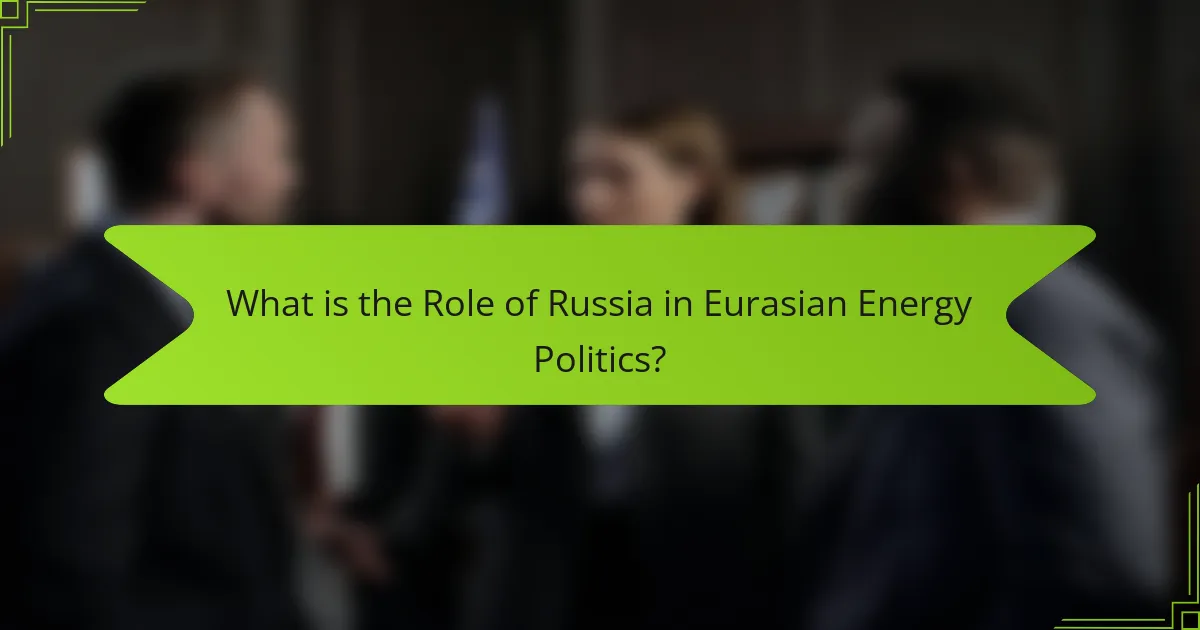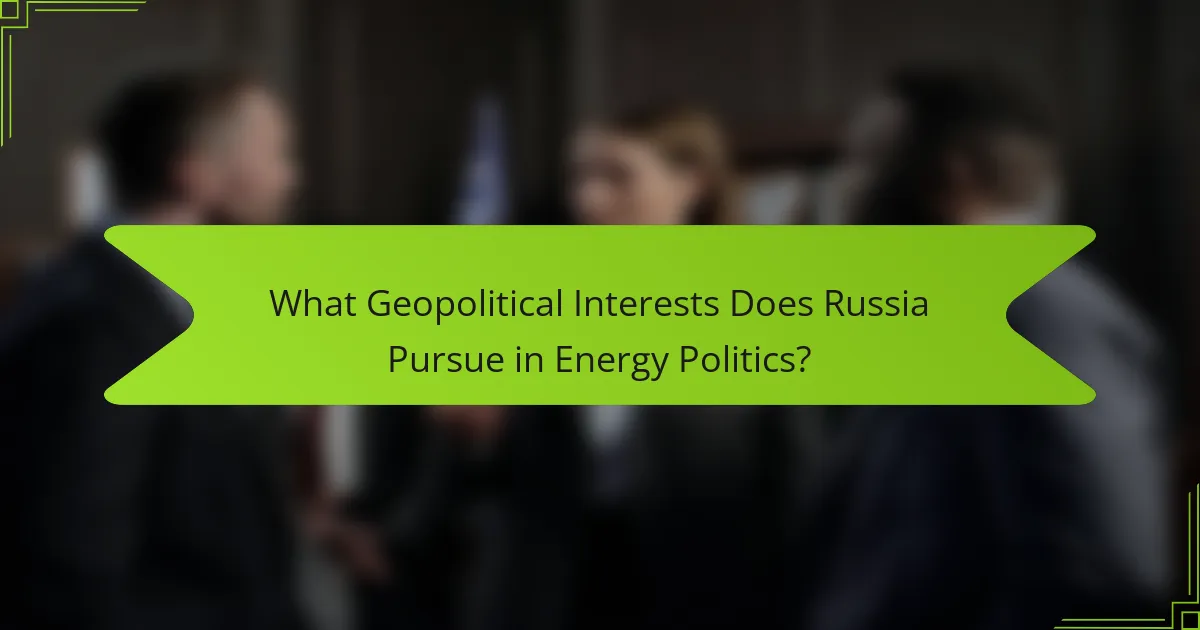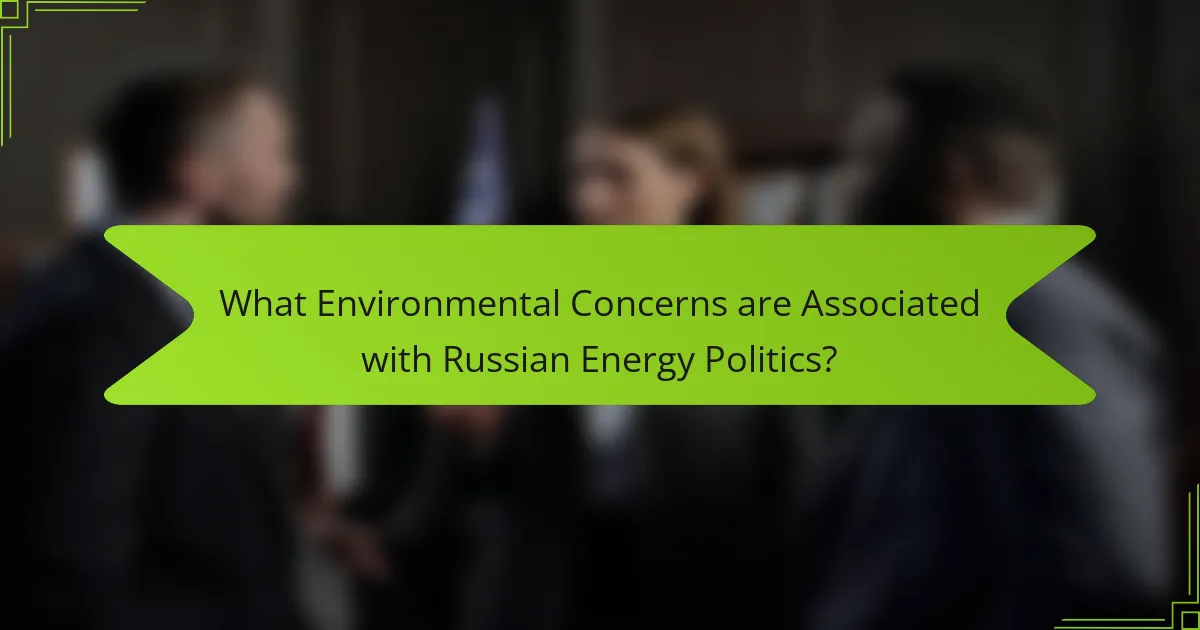Russia is a major player in Eurasian energy politics, being one of the largest producers and exporters of oil and natural gas in the region. The country’s extensive pipeline network, including Nord Stream and TurkStream, enhances its strategic influence over European and Asian energy markets. This article examines the supply chain dynamics of Russian energy, the geopolitical interests driving its energy policies, and the environmental concerns associated with fossil fuel extraction and transportation. Key aspects include Russia’s energy partnerships with neighboring countries, the impact of sanctions and political tensions on energy flow, and the implications of energy dependency on former Soviet states. The discussion highlights how these factors collectively shape the geopolitical landscape of Eurasia.

What is the Role of Russia in Eurasian Energy Politics?
Russia plays a central role in Eurasian energy politics. It is one of the largest producers and exporters of oil and natural gas in the region. The country’s energy resources significantly influence global energy markets. Russia’s pipelines, such as Nord Stream and TurkStream, enhance its strategic leverage over Europe and Asia. Additionally, Russia engages in energy partnerships with neighboring countries, strengthening its geopolitical influence. The nation uses energy exports as a tool for political power and economic stability. Historical ties and energy dependencies shape relationships with former Soviet states. Overall, Russia’s energy policies are critical in shaping the geopolitical landscape of Eurasia.
How does Russia’s energy supply influence Eurasian geopolitics?
Russia’s energy supply significantly influences Eurasian geopolitics by providing leverage over neighboring countries. This supply affects energy security for many nations reliant on Russian oil and gas. For instance, countries like Belarus and Ukraine have historically navigated complex political relationships due to their dependence on Russian energy. Additionally, Russia uses energy exports to strengthen alliances and exert influence within the region. The Nord Stream pipeline exemplifies this, as it enhances Russia’s ability to supply Europe directly. Furthermore, energy supply disruptions can serve as a geopolitical tool, affecting diplomatic relations. In 2020, Russia curtailed gas supplies to Belarus amid political tensions, demonstrating this influence. Overall, Russia’s energy resources are a critical factor in shaping the geopolitical landscape of Eurasia.
What are the key energy resources that Russia provides to Eurasia?
Russia provides key energy resources to Eurasia, primarily natural gas, oil, and coal. Natural gas is a significant export, with Russia being the largest supplier to Europe. In 2020, Russia accounted for about 40% of the European Union’s natural gas imports. Oil exports are also crucial, making Russia one of the top oil producers globally. In 2021, Russia exported over 5 million barrels per day. Additionally, coal is a vital resource, with Russia being the world’s third-largest coal producer. These resources play a critical role in the energy security of many Eurasian countries.
How do Russia’s energy exports affect its relationships with neighboring countries?
Russia’s energy exports significantly influence its relationships with neighboring countries. These exports provide economic leverage, as many neighboring nations rely on Russian oil and gas for their energy needs. For instance, countries like Belarus and Ukraine are heavily dependent on Russian energy supplies. This dependency can lead to political pressure and influence over domestic policies in these countries. Additionally, energy export agreements often serve as tools for Russia to strengthen alliances or exert control in the region. The Nord Stream pipelines exemplify this strategy by enhancing Russia’s energy export capacity directly to Europe, bypassing some neighboring countries. Overall, Russia’s energy exports shape its geopolitical relationships, impacting trade, diplomacy, and regional stability.
What are the historical contexts of Russia’s involvement in energy politics?
Russia has a long history of involvement in energy politics, beginning in the late 19th century. The discovery of oil in Baku in the 1870s marked the start of Russia’s significant role in global energy markets. By the early 20th century, Russia became one of the world’s leading oil producers. The Soviet era further solidified this status, with the state controlling energy resources as a means of economic and political leverage.
In the post-Soviet period, Russia faced challenges in maintaining its energy infrastructure. However, the 2000s saw a resurgence, as oil prices rose significantly. This allowed Russia to reinvest in its energy sector, enhancing its influence over Europe and Asia.
The construction of pipelines, such as the Nord Stream and Power of Siberia, exemplifies Russia’s strategic energy politics. These projects enable Russia to supply gas directly to key markets, bypassing transit countries.
Additionally, energy resources have been used as tools of foreign policy. Russia has leveraged gas supplies to exert influence over neighboring countries. This has often led to geopolitical tensions, particularly with the European Union and Ukraine.
Overall, Russia’s historical contexts in energy politics are characterized by its resource wealth, state control, and strategic use of energy as a geopolitical tool.
How have past events shaped current energy supply dynamics?
Past events have significantly influenced current energy supply dynamics. The collapse of the Soviet Union in 1991 led to the emergence of independent states. These states redefined their energy policies and relationships with Russia. The 2000s saw Russia leverage its natural gas resources for geopolitical influence. Events like the 2006 and 2009 gas disputes with Ukraine highlighted vulnerabilities in supply chains. Sanctions imposed on Russia due to geopolitical tensions have further complicated energy dynamics. The rise of renewable energy sources has also shifted traditional supply models. Historical decisions regarding energy infrastructure have lasting impacts on current supply routes. These factors collectively shape today’s energy landscape in Eurasia.
What role did the Soviet Union play in establishing energy ties in Eurasia?
The Soviet Union played a crucial role in establishing energy ties in Eurasia. It developed extensive energy infrastructure, including pipelines and refineries, connecting various regions. The USSR’s centralized control over energy resources facilitated the distribution of oil and gas across member states. Additionally, it engaged in bilateral agreements to secure energy supplies, influencing regional politics. The Soviet Union’s energy policies were designed to strengthen its geopolitical influence in Eurasia. Historical events, such as the establishment of the Comecon, further integrated the energy markets of Eastern Europe and Central Asia. This legacy continues to shape current energy dynamics in the region.

What are the Supply Chain Dynamics of Russian Energy?
The supply chain dynamics of Russian energy are characterized by a complex network of production, transportation, and distribution. Russia is one of the world’s largest producers of oil and natural gas. The country relies heavily on pipelines to transport energy resources to Europe and Asia. Key pipelines include Nord Stream, TurkStream, and Power of Siberia. These infrastructure projects are crucial for maintaining energy exports. Geopolitical factors significantly influence these supply chains. Sanctions and political tensions can disrupt energy flow. Additionally, domestic policies impact production levels and investment in infrastructure. The Russian government plays a central role in managing energy resources and international partnerships. This strategic control shapes the overall dynamics of the energy supply chain.
How is the energy supply chain structured in Eurasia?
The energy supply chain in Eurasia is primarily structured around the extraction, transportation, and distribution of fossil fuels. Key players include Russia, Central Asian countries, and various energy companies. Russia dominates the supply chain, being the largest producer and exporter of oil and natural gas in the region. Pipelines such as the Power of Siberia and TurkStream facilitate the transport of energy resources to Europe and Asia. Central Asian countries, like Kazakhstan and Turkmenistan, contribute significant oil and gas reserves. The supply chain is influenced by geopolitical interests, with major investments from foreign entities. Environmental concerns are increasingly shaping energy policies and practices in the region.
What are the main transportation routes for Russian energy exports?
The main transportation routes for Russian energy exports include pipelines, railways, and maritime routes. Key pipelines are the Nord Stream, which connects Russia to Germany via the Baltic Sea, and the TurkStream, linking Russia to Turkey through the Black Sea. The Power of Siberia pipeline transports natural gas to China, enhancing energy ties with Asia. Railways also facilitate the export of coal and oil to various countries. Additionally, maritime routes are essential for shipping liquefied natural gas (LNG) to global markets. These routes are crucial for Russia’s energy strategy and economic stability.
How do logistical challenges impact the efficiency of energy supply?
Logistical challenges significantly reduce the efficiency of energy supply. These challenges include transportation delays, inadequate infrastructure, and regulatory hurdles. Transportation delays can lead to longer delivery times, causing supply shortages. Inadequate infrastructure may result in bottlenecks, limiting the flow of energy products. Regulatory hurdles can complicate cross-border energy transactions, increasing costs and time. According to the International Energy Agency, poor logistics can increase operational costs by up to 30%. Efficient logistics are crucial for maintaining a steady energy supply and meeting demand.
What are the technological advancements influencing energy supply chains?
Technological advancements influencing energy supply chains include blockchain, IoT, and AI. Blockchain enhances transparency and traceability in transactions. IoT devices improve real-time monitoring of assets and energy consumption. AI optimizes supply chain operations through predictive analytics and demand forecasting. These technologies reduce inefficiencies and costs. For instance, a 2020 report by McKinsey noted that AI could increase supply chain efficiency by up to 20%. Additionally, digital twins create virtual models for better planning and risk management. These advancements are reshaping how energy is produced, distributed, and consumed.
How do innovations in extraction and transportation affect Russia’s energy exports?
Innovations in extraction and transportation significantly enhance Russia’s energy exports. Advanced extraction technologies increase efficiency and yield, allowing for greater production of oil and gas. Enhanced transportation methods, such as new pipelines and shipping routes, reduce costs and transit times. For example, the Power of Siberia pipeline facilitates direct gas exports to China, expanding market access. Additionally, innovations in liquefied natural gas (LNG) technology enable Russia to export gas to distant markets. These advancements improve competitiveness in global energy markets. Consequently, Russia can respond more effectively to international demand fluctuations. Overall, these innovations bolster Russia’s position as a leading energy exporter.
What role do digital technologies play in managing energy supply chains?
Digital technologies play a crucial role in managing energy supply chains by enhancing efficiency and transparency. These technologies include data analytics, IoT devices, and blockchain. Data analytics allows for real-time monitoring of energy production and consumption. IoT devices facilitate communication between various components of the supply chain. Blockchain provides a secure and transparent method for transactions and tracking. According to a report by McKinsey, digital solutions can reduce operational costs by up to 30%. This integration leads to improved decision-making and faster response times in energy management.

What Geopolitical Interests Does Russia Pursue in Energy Politics?
Russia pursues several geopolitical interests in energy politics. First, it aims to maintain influence over European energy markets. Russia supplies a significant portion of Europe’s natural gas, creating dependency. This dependency allows Russia to leverage energy resources for political gain. Additionally, Russia seeks to expand its energy partnerships in Asia, particularly with China. These partnerships help diversify its energy exports and reduce reliance on European markets. Moreover, Russia aims to assert its role as a global energy superpower. It invests in energy infrastructure projects like the Nord Stream and Power of Siberia pipelines. These projects enhance its strategic positioning in global energy supply chains.
How does energy influence Russia’s foreign policy decisions?
Energy significantly influences Russia’s foreign policy decisions. The country relies heavily on its vast energy resources, particularly oil and natural gas. Energy exports are a major source of revenue for the Russian economy. This economic dependency shapes Russia’s interactions with other nations. For instance, Russia uses energy supplies as a tool for political leverage. It has historically manipulated gas supplies to influence countries in Europe and Central Asia. The Nord Stream pipeline exemplifies this strategy, enhancing energy ties with Europe while bypassing Ukraine. Furthermore, energy partnerships with countries like China and India diversify Russia’s foreign relations. Overall, energy resources are central to Russia’s geopolitical strategies and foreign policy objectives.
What strategic alliances does Russia form through energy agreements?
Russia forms strategic alliances through energy agreements primarily with countries in Europe and Asia. Notable partnerships include agreements with China for gas supply, such as the Power of Siberia pipeline. This pipeline enhances energy security for China while providing Russia with a significant market. Additionally, Russia has strengthened ties with countries like Germany through the Nord Stream projects. These projects facilitate direct gas supply routes to Europe, bypassing traditional transit countries. Such alliances are crucial for Russia’s economic stability and geopolitical influence. Energy agreements also help Russia counterbalance Western sanctions by diversifying its energy export routes. Overall, these alliances are integral to Russia’s strategy in Eurasian energy politics.
How do sanctions impact Russia’s geopolitical energy strategies?
Sanctions significantly impact Russia’s geopolitical energy strategies by limiting its access to international markets and technology. These restrictions hinder Russia’s ability to develop new oil and gas projects. As a result, Russia seeks alternative markets, particularly in Asia, to offset losses in Europe. The sanctions also incentivize Russia to strengthen ties with non-Western countries. This shift alters global energy supply chains and increases competition for influence in Eurasia. Furthermore, Russia invests in domestic production technologies to reduce reliance on Western expertise. Historical data shows that post-sanction periods have led to a decline in Russian energy exports to the West. This dynamic reshapes the geopolitical landscape and energy alliances in the region.
What are the implications of energy dependency for Eurasian countries?
Energy dependency for Eurasian countries leads to increased vulnerability in geopolitical dynamics. These countries often rely heavily on energy exports, particularly from Russia. This reliance can limit their political autonomy and influence. For instance, energy-dependent states may face pressure to align with Russian interests. Economic stability is also at risk, as fluctuations in energy prices can impact national revenues. Additionally, energy dependency can hinder diversification efforts in their economies. Countries like Kazakhstan and Azerbaijan illustrate these challenges. Their economies are closely tied to energy markets, making them susceptible to external shocks. Ultimately, energy dependency shapes both domestic policies and international relations in the region.
How does energy dependency affect political stability in the region?
Energy dependency significantly impacts political stability in the region. High reliance on energy exports can make economies vulnerable to fluctuations in global energy prices. Countries with limited energy resources may experience instability when external suppliers leverage energy as a political tool. For instance, Russia has historically used energy supplies to exert influence over neighboring states. This dependency can lead to tensions and conflicts, particularly when energy resources are scarce or contested. Furthermore, energy dependency can hinder economic diversification, making nations less resilient to external shocks. Overall, energy dependency creates a complex interplay between economic reliance and political power dynamics.
What are the risks associated with over-reliance on Russian energy supplies?
Over-reliance on Russian energy supplies poses significant geopolitical and economic risks. These risks include vulnerability to supply disruptions due to political tensions. For example, conflicts between Russia and neighboring countries can lead to pipeline shutdowns. Additionally, dependency on Russian energy can limit diversification of energy sources. This can result in higher energy prices and reduced energy security for reliant nations. Historical instances, such as the 2006 gas dispute between Russia and Ukraine, illustrate these vulnerabilities. Furthermore, reliance on a single supplier can hinder the development of renewable energy initiatives. This can impede long-term sustainability goals in energy policy.

What Environmental Concerns are Associated with Russian Energy Politics?
Russian energy politics raises significant environmental concerns. The extraction and transportation of fossil fuels contribute to greenhouse gas emissions. This exacerbates climate change and impacts global temperatures. Additionally, oil spills and gas leaks pose risks to ecosystems. The Arctic region, a focus for Russian energy expansion, faces threats from melting ice and habitat destruction. Deforestation linked to pipeline construction disrupts biodiversity. Furthermore, reliance on fossil fuels hinders renewable energy development. These factors collectively highlight the environmental implications of Russian energy strategies.
How does energy extraction impact the environment in Eurasia?
Energy extraction significantly impacts the environment in Eurasia. It leads to habitat destruction, pollution, and biodiversity loss. The extraction processes often result in oil spills and gas leaks. These incidents contaminate soil and water resources. Deforestation occurs as land is cleared for drilling and mining operations. Air quality deteriorates due to emissions from extraction activities. Additionally, climate change is exacerbated by greenhouse gas emissions from fossil fuel extraction. Specific regions, like Siberia, face permafrost thawing due to these activities. This further destabilizes ecosystems and contributes to global warming.
What are the ecological consequences of oil and gas drilling in Russia?
Oil and gas drilling in Russia leads to significant ecological consequences. These activities contribute to habitat destruction, particularly in sensitive areas like the Arctic. Oil spills are a common risk, causing long-term damage to marine and terrestrial ecosystems. The extraction process generates greenhouse gas emissions, exacerbating climate change. Additionally, drilling operations can pollute water sources, affecting local wildlife and communities. Deforestation often occurs to clear land for infrastructure, further disrupting ecosystems. Soil contamination from drilling fluids poses risks to agriculture and biodiversity. The cumulative impact threatens the resilience of natural habitats and species in the region.
How does climate change influence energy policies in Russia?
Climate change significantly influences energy policies in Russia by prompting a shift towards renewable energy sources. The Russian government has recognized the need to reduce greenhouse gas emissions. This recognition aligns with global climate agreements, such as the Paris Agreement. Consequently, Russia has set targets for increasing renewable energy capacity. For instance, the country aims to generate 4.5% of its energy from renewable sources by 2024. Additionally, climate change impacts the operational efficiency of existing fossil fuel infrastructures. Extreme weather patterns can disrupt energy supply chains and production. This has led to increased investment in energy efficiency technologies. Overall, climate change is reshaping Russia’s long-term energy strategy.
What initiatives are in place to address environmental impacts?
Russia has implemented several initiatives to address environmental impacts. These initiatives include the adoption of the National Ecology Project, which aims to improve air and water quality. The project also focuses on waste management and biodiversity preservation. Additionally, Russia has committed to reducing greenhouse gas emissions under the Paris Agreement. The country is investing in renewable energy sources, such as wind and solar power. Furthermore, Russia is enhancing regulations for industrial emissions and promoting sustainable forestry practices. These measures reflect a broader commitment to environmental sustainability and climate action.
How is Russia balancing energy production with environmental sustainability?
Russia is balancing energy production with environmental sustainability through investments in cleaner technologies and renewable energy sources. The country aims to reduce greenhouse gas emissions while maintaining energy output. In 2020, Russia pledged to achieve carbon neutrality by 2060. This commitment involves increasing the share of renewables in its energy mix. As of 2021, renewables accounted for approximately 5% of total energy production. Russia is also enhancing energy efficiency in traditional sectors. The government supports projects that promote sustainable practices in fossil fuel extraction. These efforts reflect a strategy to align economic growth with environmental stewardship.
What role do international agreements play in shaping Russia’s environmental policies?
International agreements significantly influence Russia’s environmental policies. These agreements create frameworks that compel Russia to adopt specific environmental standards. For instance, Russia is a party to the Paris Agreement, which mandates commitments to reduce greenhouse gas emissions. This participation encourages the development of national strategies aimed at sustainability. Additionally, international agreements often include financial incentives for compliance. They can also facilitate technology transfer, enhancing Russia’s capacity for environmental protection. Furthermore, global environmental norms shape public expectations and political discourse within Russia. As a result, international agreements play a crucial role in aligning Russia’s policies with global environmental goals.
What are the best practices for engaging with Russian energy politics?
Engaging with Russian energy politics requires a multifaceted approach. First, stakeholders should prioritize understanding the geopolitical landscape. Russia’s energy policies are deeply intertwined with its foreign policy goals. Second, collaboration with local experts can provide valuable insights into regional dynamics. Third, maintaining open communication channels with Russian counterparts fosters trust and transparency. Fourth, leveraging data and analytics can enhance decision-making processes. Additionally, stakeholders should remain adaptable to shifts in energy markets and policies. Finally, monitoring international sanctions is crucial to ensure compliance and mitigate risks. These practices align with historical trends in Russian energy diplomacy, demonstrating their effectiveness in navigating complex political environments.
The main entity of the article is Russia and its role in Eurasian energy politics. The article examines Russia’s significant influence as a leading producer and exporter of oil and natural gas, detailing its strategic leverage through pipelines and energy partnerships. It discusses the impact of Russia’s energy supply on geopolitical dynamics, the historical context of its energy policies, and the implications of energy dependency for neighboring countries. Additionally, the article addresses the environmental concerns associated with energy extraction and the initiatives Russia has implemented to balance energy production with sustainability. Key topics include supply chain dynamics, geopolitical interests, and the ecological consequences of Russian energy politics.